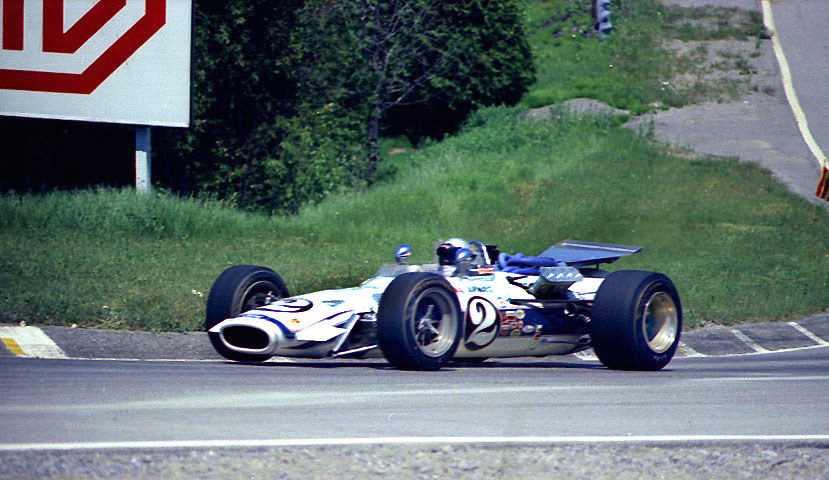Today’s safe race tracks have lost their character
 |
| Laguna Seca 1963 |
I liked the old Road Atlanta. You know. The “dangerous" one.
Someone told me they installed another chicane along the once-glorious, 200-mph backstretch since I last raced there. I don't like it. I didn't like the first one, either.
The constant effort to insulate drivers from danger has resulted in a bunch of lukewarm, sanitized race tracks that have lost their ability to reward risk that no longer exists. Their personality is gone. In many cases, their history is, too, because a race fan from the 1960's wouldn't even recognize the same facility today.
 |
| The 2nd Chicane at Road Atlanta |
 |
| Road Atlanta esses |
They've ruined the legendary Mulsanne Straight at LeMans. Years ago, race driver Terry Lingner ran LeMans and told me of his experience. Terry said, “In all the years I've been racing, Mulsanne was the first time I ever looked out the window and thought, 'Man, if I crashed at this speed it could really hurt.'"
Not so anymore. Mulsanne is no longer the test of nerve and skill that it once was. Now pretty much everybody can go the same speed.
The first time I ran Nelson Ledges Sports Car Course – which, by the way, is a great, historic and underrated facility – I got there a day early so the manager, Scott Lane, could give me the grand tour and show me how to drive the track.
We went out in a two-seat sports car with Scott at the wheel. As we rounded the Carousel, I noticed that Scott was staying very low on the track at moderate speeds. I shouted over the engine to him, “Why couldn't I use more track here? Could pick up a few tenths."
Scott shouted back, “Because you don't know what's on the other side." Turns out that the Carousel is surrounded by a huge ditch beyond which is a row of car-killing trees.
Yup, I was a little nervous coming out of the Carousel in a Rolex car the next day after well over a hundred miles per hour. But it was so fresh and exhilarating. Finally, a corner where everyone can't go the same speed without some risk.
Stirling Moss is tired of sanitized, safe racetracks, too. He famously told Top Gear magazine, “I'd build a brick wall all around the outside of today's tracks. All this (grass and sand traps) they run off into, personally, I think it spoils it."
This from a guy whose career ended after spending a month in a crash-induced coma.
“Formula One has become a safe sport. It has no more risk than football," Moss said. “The new level of safety emasculates the sport. People say I advocate being killed. It's not advocating killing, but the freedom to drive with danger."
Or without it, if you want to slow down.
A few years back all the NASCAR drivers got in a huff over one of Bruton Smith's ovals, claiming the final turn was “too dangerous for stock cars." Well, first of all, NASCAR hasn't raced stock cars in forty years.
Pause for effect.
Secondly, what NASCAR teams were really complaining about wasn't the “danger" of the turn, but rather the inability to take the corner flat out without smacking the wall.
But if everyone can drive the entire track at full throttle with little or no risk, what's to separate average drivers from the true greats?
Thank heavens, the Indianapolis Motor Speedway is still dangerous. The only major change there in the last century has been the Safer Barriers, which do not compromise the track configuration. It's no coincidence that, unlike many other tracks with great histories, the old Brickyard is still revered as the gold standard for race facilities worldwide.
A few years ago I was chatting with Supercross legend Jeremy McGrath after a race in Portland. I asked him how he could ride so fast, yet remain uninjured for so many years. He responded, “Because I ride within myself. Other riders have to over-extend themselves to ride the same speed, and that's when they get hurt. If you advance your skill level, you can ride within yourself and not get hurt."
McGrath wasn't bragging. He was a humble guy who was surprisingly down to earth. He was just telling the truth. Instead of reaching beyond your ability or asking the track to be compromised in order to accommodate average drivers, why not focus on advancing your skills and driving within them?
Ultimately, it is impossible to build a “dangerous" track because every corner is safe if you slow down. If you don't feel safe at a certain point on the racetrack, you're free to take your foot off the throttle and make it as safe as you like.
There's no such thing as a “dangerous" track. There are only dangerous speeds, and speed is within the driver's control.
 |
| St. Jovite 1968 |
The Nurburgring, Road America and Watkins Glen still have some of their original charm. Nelson Ledges is virtually unchanged after 40 years. Oklahoma's Hallett Motor Racing Circuit, one of my favorite gems from the early 1970's, still retains its originality.
But they are the exception, not the rule. We have very few original, “dangerous" race tracks left. The few that remain are relics of a bygone age when risk was accepted, skills were rewarded, and no one got a trophy for participation.
I say we leave them alone.
Stephen Cox
